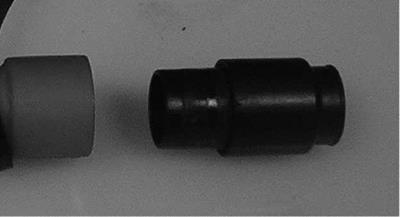A common application for adhesives is where co-axial (cylindrical parts) require to be joined. Figure 5.11 shows a typical application where the black polypropylene spigot is to be bonded and sealed into the red elastomeric (thermoplastic elastomers) housing. In this case, both these plastics are low-surface-energy materials and so will require either a surface primer or some form of surface treatment to increase the surface wetting (see Chapter 6). In this application a medium viscosity ethyl cyanoacrylate with a primer was selected.
The length to diameter (L/D) ratio and the diametral clearances are both important factors in terms of the final strength of the bond. In this application the L/D ratio is 1.2 and so ideally suited for an adhesive.
|
Figure 5.11 Joining dissimilar plastics (cylindrical joint) |
Thin bond lines where the diametral clearance is less than 0.1 mm are usually best for most industrial applications.
Figure 5.12 shows a much higher L/D ratio and in this application a cyanoacrylate might not be the most appropriate adhesive as it may cure before the parts can be fully assembled. For long engagement lengths such as these and where the outer (female) substrate is opaque (and a ultraviolet (UV) adhesive cannot be used) then the adhesive can be wicked into the joint after assembly [3]. Note the small chamfer in Figure 5.12 to allow for this capillary action. In this case a diametral clearance of 0.04 mm has been selected as the low viscosity cyanoacrylates have limited gap-filling capabilities. If the gaps were larger (0.2 mm) then a two-part acrylic or epoxy may be the most appropriate adhesive.
If the outer (female) substrate had been transparent in Figure 5.12, it may have been possible to use an ultraviolet-curing adhesive. The benefit of UV adhesives is that the product will only cure ‘on demand’ and so there will be plenty of time to rotate the component parts to ensure full joint coverage. Where the assembly process is horizontal, the chamfer is not always necessary but the male part may require to be rotated to ensure full joint coverage.
 29 октября, 2015
29 октября, 2015  Pokraskin
Pokraskin 
 Опубликовано в рубрике
Опубликовано в рубрике 